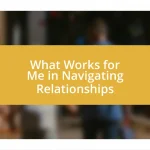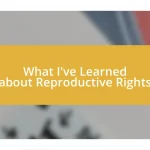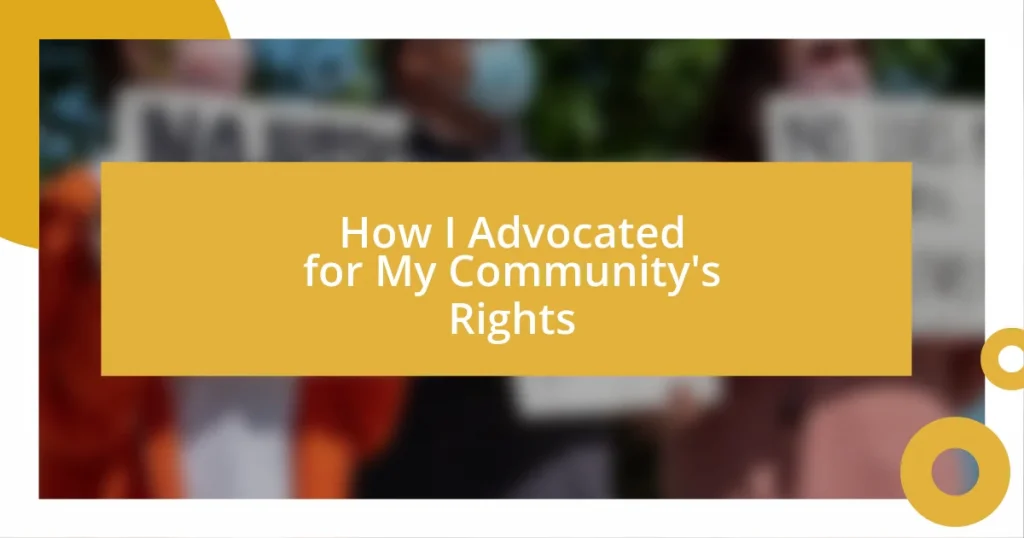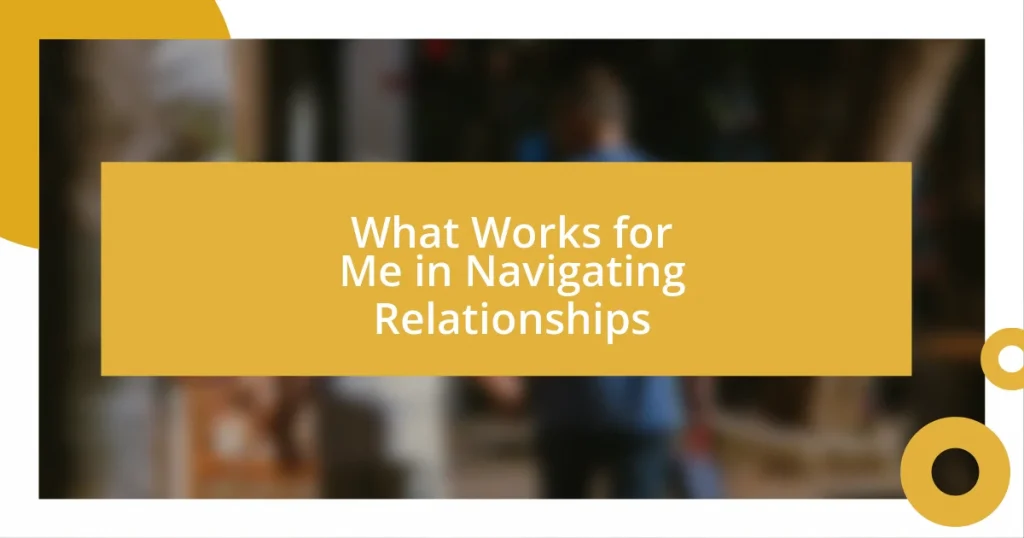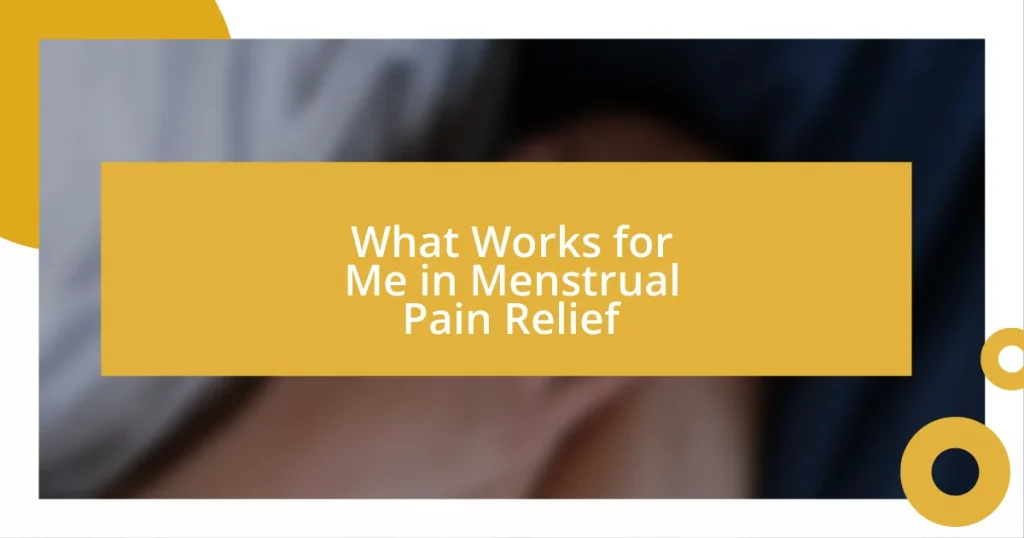Key takeaways:
- Community rights are fundamental to individual dignity and collective empowerment, emphasizing the importance of being heard in decision-making.
- Building a diverse support network and engaging in open dialogues reveal pressing community issues and create impactful partnerships for advocacy.
- Evaluating advocacy impact involves both qualitative stories and quantitative data, highlighting the transformation of community dynamics and individual empowerment through collective action.
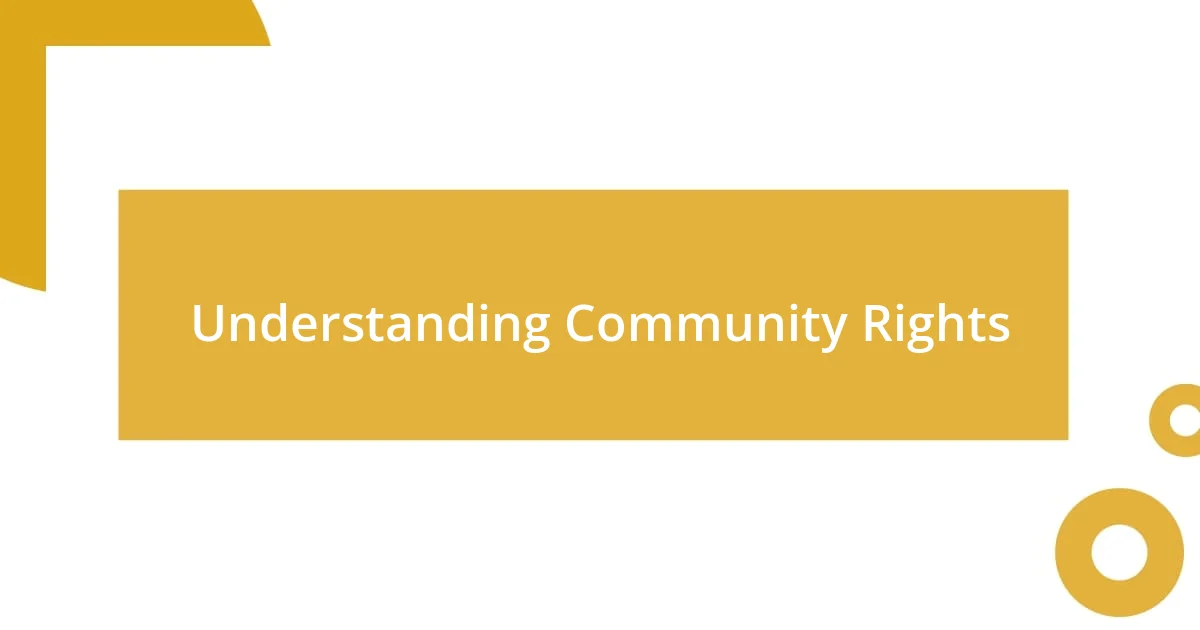
Understanding Community Rights
Understanding community rights goes far beyond the legal jargon and policies; it’s about recognizing the inherent dignity and worth of every individual in a collective space. When I first got involved in advocacy, I realized that these rights are the foundation of our identity as a community. Have you ever felt that rush of empowerment when you stand up for something you believe in? It’s that very sense of connection that binds us together.
I remember attending a local town hall meeting where residents passionately shared their concerns about environmental issues affecting our neighborhood. There was a palpable energy in the room—a mix of frustration, hope, and determination. In those moments, I understood that community rights encompass not only our voices but also our ability to influence decisions that impact our daily lives. Isn’t it empowering to know that we share that responsibility?
Reflecting on these experiences, it strikes me how crucial it is for everyone to grasp what community rights entail. It’s not just about the right to speak but also the right to be heard and valued. Have you ever felt overlooked when decisions were made about your area? I know I have, but it highlighted the need for active engagement. Understanding community rights thus becomes a pathway to strengthen our bonds and advocate for the changes we all deserve.

Identifying Community Issues
Identifying community issues often starts with an open dialogue among residents. I’ve found that simply listening to my neighbors can reveal shared frustrations and concerns that might otherwise go unnoticed. For instance, during one neighborhood clean-up, I overheard several people lamenting about the lack of public green spaces. Those casual conversations lit a spark in me, prompting deeper discussions about not just that issue, but others that were layered beneath the surface.
Here’s a list of common issues that often emerge when communities come together to voice their concerns:
- Inadequate access to healthcare services
- Unsafe public transportation options
- Lack of affordable housing
- Environmental degradation and pollution
- Insufficient recreational areas for youth and families
- Limited job opportunities
- Unfair zoning laws impacting local businesses
By recognizing these intertwined challenges, we can begin to map out a collective approach for advocacy. It’s truly eye-opening to realize how connected we all are, and how the collective experiences of a community can sharpen our focus on the bigger picture. In my journey, every conversation has become a stepping stone toward understanding what we must tackle together.

Building a Support Network
Building a support network can truly amplify the power of community advocacy. When I first started reaching out for support, I wasn’t sure where to turn. I attended local meetings and community events, where I connected with like-minded individuals who were equally passionate about making a change. One evening, I shared my vision for improving our neighborhood’s resources, and to my surprise, I found several people ready to join me. It was a warm reminder that unity can blossom from shared aspirations.
As I built relationships, I learned the importance of diversifying my network. I sought connections not only with residents but also with local businesses, nonprofit organizations, and even sympathetic local officials. I recall a moment at a community fair when a local business owner approached me after hearing about my advocacy. His support led to a collaboration that provided funding for our first neighborhood initiative. Isn’t it amazing how a simple conversation can open doors you didn’t even know existed?
Throughout this journey, I often reflect on the challenges we face together. One pivotal experience was during a local rally where we united with people from various backgrounds, each sharing their stories. The emotional energy was palpable, and it created an unbreakable bond among us. In moments like those, I realized that a strong support network isn’t just about numbers; it’s about genuine relationships formed through understanding and shared experiences. Don’t you think that having that level of connection makes our advocacy efforts feel more powerful?
| Aspect | Explanation |
|---|---|
| Networking Events | Attending meetings and fairs can lead to valuable connections. |
| Diverse Allies | Engaging with various groups enhances support and resources. |
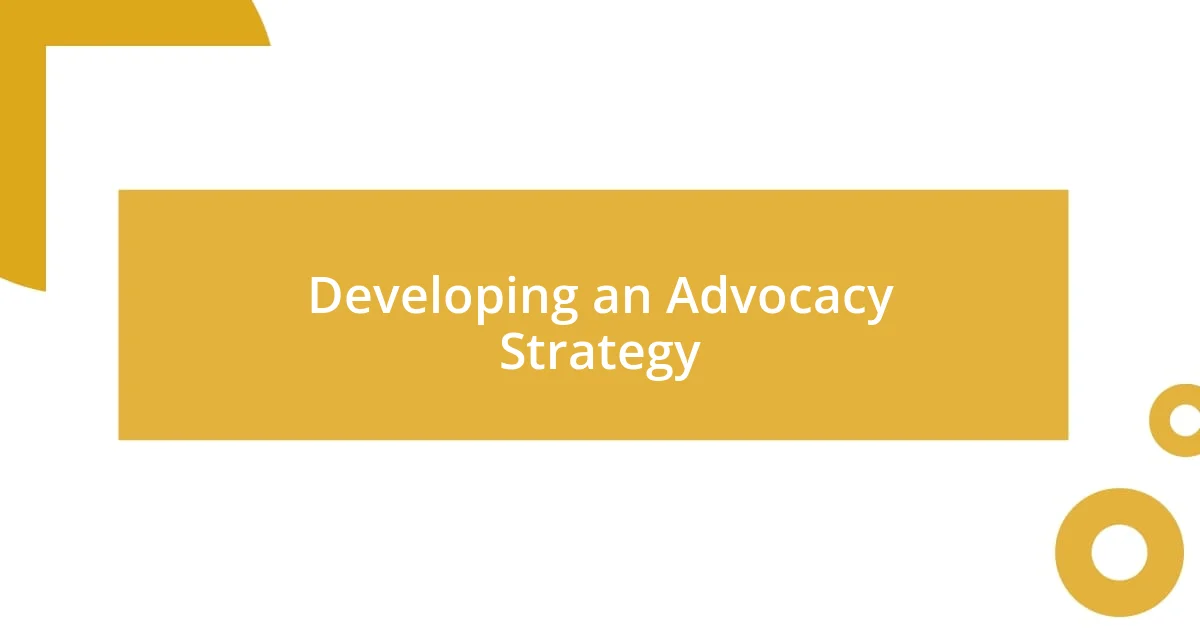
Developing an Advocacy Strategy
Developing an advocacy strategy is really about establishing clear, actionable goals. I remember sitting down with a few close friends to brainstorm our objectives—we wanted to tackle the issue of public green spaces but felt overwhelmed by all the possibilities. It was a moment of clarity when we decided to prioritize what mattered most to our community and laid out a step-by-step plan. This approach made the seemingly daunting task of advocacy feel achievable and rewarding.
I found that creating a timeline helped us stay focused and motivated. Each small victory, like securing permits for a community garden or organizing a cleanup day, served as a reminder of our progress. One particularly memorable day involved planting trees in a neglected park; I felt a surge of pride watching kids play in the newly green area. It’s incredible how concrete changes can energize a community, isn’t it?
Engaging with stakeholders is another crucial element in strategy development. Early on, I drafted a list of local officials and organizations that could either hinder or help our advocacy efforts. During a visit to a city council meeting, I nervously presented our case for more recreational spaces, my heart racing with each word. To my surprise, a council member acknowledged the need for community input and offered to support us. That exhilarating moment reinforced my belief in the power of clear communication and collaboration—sometimes, taking that bold step can lead to unforeseen partnerships!
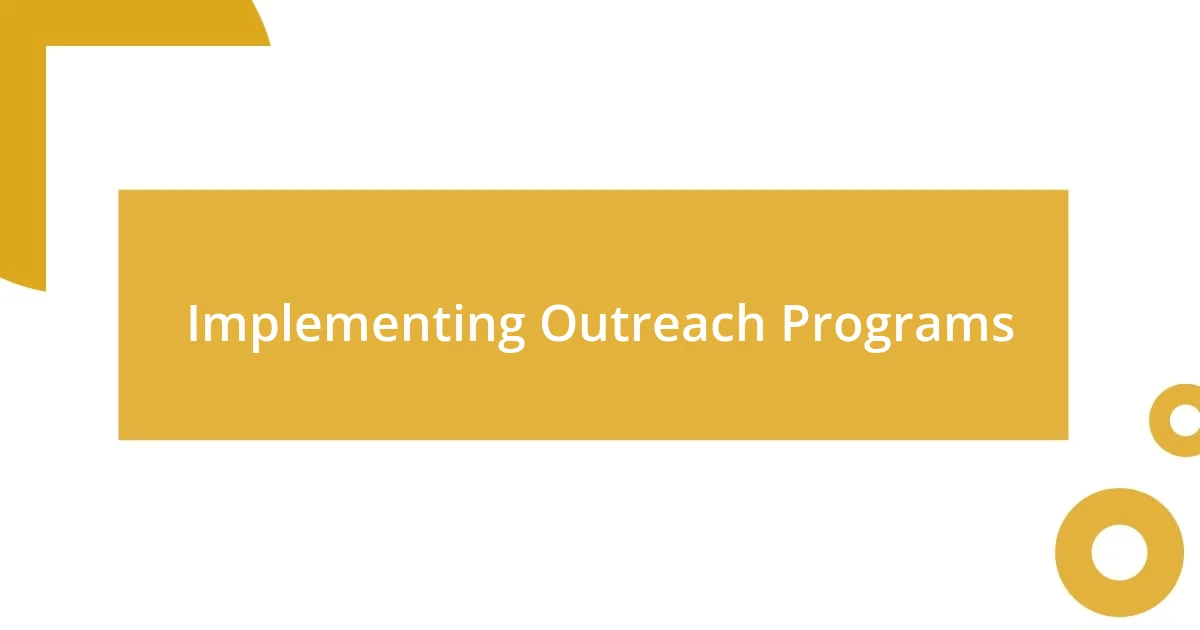
Implementing Outreach Programs
Implementing outreach programs is a vital component of community advocacy that truly brings voices together. I remember the thrill of organizing our first outreach event. We set up a booth at a neighborhood festival, with informational flyers and a warm invitation for dialogue. To my delight, many residents stopped by and shared their stories, expressing their needs and concerns. Isn’t it incredible how a simple setup can open up such meaningful conversations?
One particular outreach initiative that stood out was a series of workshops aimed at educating residents about their rights. I wasn’t sure what to expect, but the turnout was heartening. Watching a group of people, young and old, engage in discussions about their rights transformed the atmosphere. It was empowering to witness them gain confidence; sharing knowledge sparked a newfound commitment among participants to advocate for one another. When you see that awareness take root, it’s like planting seeds of change that will grow over time.
As I continued with outreach efforts, I learned the importance of consistency and follow-up. After our workshops, we established a monthly newsletter to keep everyone informed and connected. I often received heartfelt messages from attendees expressing how our programs had inspired them to take action. This feedback reinforced the idea that outreach isn’t just about initial contact; it’s about nurturing ongoing relationships that foster community solidarity. Don’t you find it fulfilling when your efforts translate into real change for those around you?

Engaging with Local Government
Engaging with local government is fascinating, especially when you realize your voice matters. I still remember my first visit to a city council meeting. I felt a mix of excitement and fear as I prepared to share our community’s needs with officials. That moment when I articulated our concerns was both terrifying and empowering. It reminded me that advocacy starts with simply speaking up.
Not long after that initial meeting, I decided to set up one-on-one sessions with local representatives. I reached out via email, sharing our community’s most pressing issues, and to my surprise, many were eager to meet. During a particularly impactful conversation with a councilperson, I felt a genuine connection as we discussed how neglected parks impact mental health. It felt like we were both on that same page, working towards a common goal, which was invigorating.
I’ve learned that persistence is key in building these relationships. During another follow-up meeting, my passion paid off when a city official committed to allocating funds for neighborhood improvements. Every exchange, whether big or small, reinforced the idea that our local government is there to serve us, too. Have you ever felt that synergy when discussing community issues? It can truly transform your commitment to advocacy!

Measuring Advocacy Impact
Evaluating the impact of advocacy requires a keen understanding of both qualitative and quantitative outcomes. I recall compiling surveys and feedback forms after each community workshop. Seeing the numbers was gratifying, but it was the personal stories that truly moved me. One participant shared how our session helped them challenge a concerning policy, which reminded me that every voice counts in creating tangible change.
While numbers paint a picture, stories provide depth. After our outreach initiatives, I began hosting small focus groups to dive deeper into what we had achieved. The candid discussions brought to light insights that metrics alone couldn’t capture. One woman shared that, because of our advocacy efforts, she felt empowered to apply for a position in the local board. Moments like these illuminated just how far-reaching our advocacy could be, transforming lives beyond just policy changes.
Ultimately, measuring impact is more than just tallying successes; it’s about understanding the shifts in community dynamics. As I forged connections and saw individuals stepping up as advocates themselves, I felt a surge of hope. Isn’t it fascinating how collective action can inspire change at both personal and societal levels? Reflecting on these impacts, I’ve learned that every interaction, every story, adds layers to our advocacy journey.
